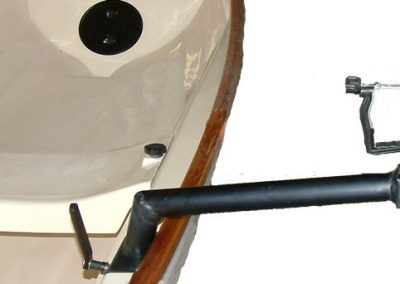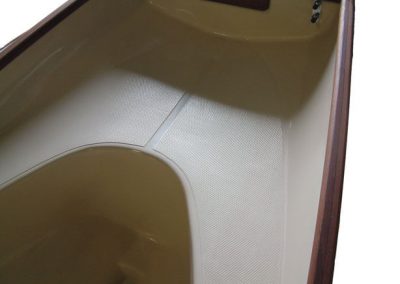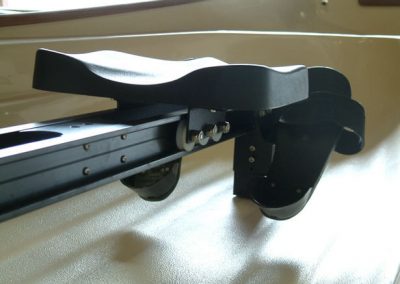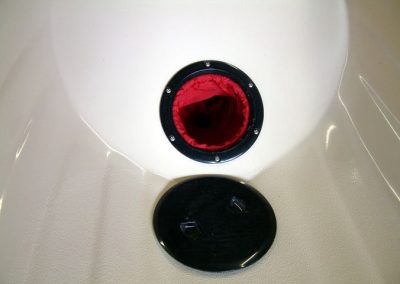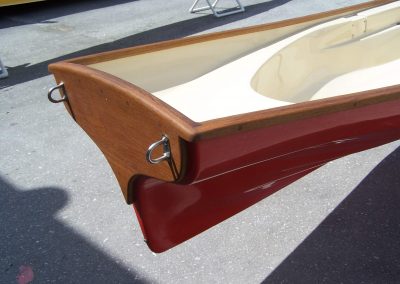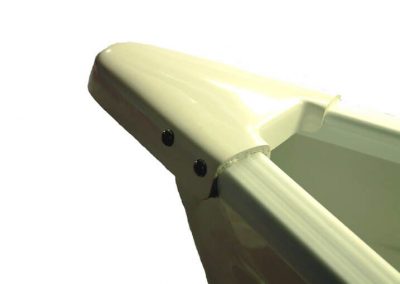How to choose a boat
Information to help you decide which rowing craft is best for you.Boat Overview
Guidence on where to begin
our brochure
Just click to view or download
Why Choose Us?
Get to know Little River Marine
Skiff vs Shell
Which boat is best for you?
Have questions?
A great grouping of helpful reources.
Why Rowing?
In today’s quest for a more healthy and exhilarating lifestyle, the sport of recreational rowing has emerged. Many doctors, sports medicine specialists, and fitness enthusiasts are proclaiming it the ideal exercise and for some very good reasons.
- One, rowing combines a full-body fitness sport with a recreational activity, offering a complete physical and mental conditioning program all in one.
- Two, rowing requires a minimum of skills to achieve, (you can learn to row in one afternoon), yet will remain a challenge throughout the years as you continue to improve.
- Three, people of all ages, sizes, and physical limitations can learn to row and achieve a level of accomplishment that is both physically beneficial and personally rewarding. Rowing is now recognized as an effective means of therapeutic conditioning used in various applications, such as for joggers with bad knees to those physically handicapped.
- Fourth, and most important, rowing puts you in a unique and refreshing atmosphere-far from the madding crowd-one that stimulates your senses while challenging your efforts.
You’ll come to find that rowing never encourages boredom; that you’ll actually look forward to your next row, whether it’s to workout or work less. The fascinating sport of rowing, simply put, is a fun way to stay fit.
Topics to consider when choosing your rowing craft.
First, what are your typical athletic tendencies in a sport? Are you interested in building skills in a new sport (shells) or are you simply looking for a hassle-free way to enjoy exercising outdoors (skiffs)? Are you interested in rowing by yourself, or with someone else? Will you take friends or family along?
Second, what are the typical water conditions at the time and place you will most often row? These questions will help maximize the enjoyment of your purchase.
Question most often asked: I’m attracted to shells, but heard they are tippy. What should I expect? Here is the well-kept secret about all shells: if you let go of the oars, you will probably tip over. If that is not for you, consider the Heritage skiff. We get far more people switching out of shells into skiffs (especially other brands where the buyer was misled as to the difficulty of shells) than skiffs to shells.
.
Our rowing craft are classified into three types including flat water shells, open water shells, and traditional skiffs
Flat water shells are for racing and serious training. They are best suited for athletic people who do most of their rowing on calm water. Their speed is amazing and graceful.
Open water shells are great fun and exercise, and with some experience, can even handle the ocean on a light breezy day. They are light, fast, and exciting to row. In calm waters almost anyone can learn to row one, and they take intermediate skills to row in open choppy waters.
Traditional skiffs are a joy to row and easy to learn by anyone. Very stable, they are the perfect exercise boat and can even carry passengers. Safe and dry, our Heritage skiffs are aesthetically beautiful and well crafted.
Why Choose Little River Marine?
A Name You Can Count On
Little River has been building shells since 1977, and has remained owned and managed by the original designer, Bill Larson. Today Little River is the largest builder of recreational sliding seat boats in America. With an endorsement record that includes NASA, the Armed Forces, the Boy Scouts of America, and Boating Industry’s “Top 100 Products.” We gained national recognition in Small Boat Journal’s “Sea Trials” by earning a Number One ranking overall in the recreational doubles test.
A Rowing Shell You Can Grow With
The foundation of Little River’s success story began when brothers William and Steve Larson forecasted the future of recreational rowing by creating an entirely new concept: designing a full line of performance craft built for recreational standards. Every aspect of the sport from pure leisure to highly skilled rowing is accommodated in each one of our models. We then go a step further and design a unique feature into each unit: as one’s rowing technique and ability improves, so does the performance of the shell. Too many entry-level shells on today’s market reach their performance peak long before the rower, and they soon become candidates for “trade-ins” or “dust catchers.” Little River’s foremost goal is to offer each individual rower a uniquely designed craft that will properly educate from day one, while continuing to reward the rower’s efforts for as long as the sport is enjoyed: offering you the best of both worlds.
Exclusive Features Are Standard With Little River
Design features that normally come as extras with other manufacturers are standard on most Little River boats — such as Carbon Fiber construction, allowing for lighter weight hulls and superior rigidity. One piece, non-skid, molded decks and interiors add beauty, strength and less maintenance.
State-of-the-art, lightweight aluminum rigging systems mount in seconds, and are as stiff as iron. Attached to the top of the shell, the wing rigger carries its own loads, thus requiring less structure inside the hull. Our design incorporates no bends because bends are weaker than welds and absorb energy meant to propel the shell forward.
Unique fold-in riggers on Heritage models provide easier docking and transporting.
Our exclusive Universal Pitch� is the easiest oar lock adjustment system on the market, and the only 4-way fully adjustable system available on any recreational shell.
Assurance
Our exclusive lifetime trade-in policy:
Let’s say you opt for a Cambridge, but later decide you’d like to get a double, or maybe a racing shell. No problem! Our published trade-in policy guarantees you a generous trade-in value on your current shell for life. Why? We want to insure that you’ll always have the opportunity to row the boat that’s best for you now and in the future … We are the only manufacturer that offers this policy – it’s one more reason we can be your “rowing craft company for Life!
Rowing skiff or rowing shell
Which is the right pick for you?

Why choose a rowing skiff?
Are you looking for the stability of a sliding seat row boat?
Do the sweeping graceful lines of this sliding seat row boat appeal to you?
If so, a Heritage skiff from Little River Marine is the boat for you!
What are the advantages of a Heritage Skiff over a rowing shell?
Because of their wider hulls, sliding seat row boats are more stable than rowing shells. With a Heritage you can stand up. With a shell, there is well kept secret: let go of the oars, tip right over (shells, not skiffs).
A Heritage is only one mph slower than a shell at cruising speed. Average speed Heritage 5 mph, shell 6mph. So you give up little, but gain a lot.
Each Heritage model has enough room to carry passenger(s), and the Heritage 15 and 18 have the ability to accommodate a second rower.
A motor mount or sail can be mounted on your sliding seat row boat.
Little River Marine’s patented folding rigger system makes the boat easy to transport.
Why Choose a Rowing Shell?
Do you want the speed and grace of a rowing shell?
Can you imagine sliding across the water in a sliver of motion, rowing effortlessly as you surge forward?
Do you dream of the oars chanting their cadence?
If so, one of Little River Marine’s rowing shells is the boat for you!
What are the advantages of a rowing shell?
Light weight; our rowing shells start at only 39 pounds, making them easy for one person to carry.
Speed; because of their narrower hulls, a rowing shell is faster in the water than a dory.
Low-Impact rowing doesn’t involve any jarring motion like jogging, tennis, or other sports.
Easy to set up; easy to mount rigging systems make setting up Little River’s rowing shells a breeze.
Boat Construction
Since 1977, Bill Larson has been designing and manufacturing rowing shells with an emphasis on superior quality.
Heritage Models
As with our rowing shells, Little River has place strict attention to ensuring that our skiffs deliver beyond the expectations of our customers. The Heritage class all come standard with molded, non-skid interiors that provide a comfortable and dependable rowing craft. Also, our interiors come standard with passenger seats that can accommodate members of your family for a fun filled day on the lake. You may also remove the six-wheeled, sliding seat from your heritage to convert to a traditional fixed-rowing craft. A unique feature to our skiffs is the fold-out rigger system that enables your Heritage to be stored easily. Finally, the full-length keel provides true tracking as you paddle through the water.

Rowing Shells
Among one of the unique features of the rowing shells is the molded splash gaurd that ensures a “dry ride”. In addition, all of our rowing shells have complete carbon fiber decks and hulls for superior performance and durability.
Construction Gallery
As you can see, our boats come standard with numerous features that others typicall charge extra for.
Our Heritage Line has three Construction Methods
Little River Marine’s Quality Construction
Since 1977, Bill Larson has been designing and manufacturing rowing shells with an emphasis on superior quality.
Rowing Skiffs, Heritage Models
As with our rowing shells, Little River has place strict attention to ensuring that our skiffs deliver beyond the expectations of our customers. The Heritage class all come standard with molded, non-skid interiors that provide a comfortable and dependable rowing craft. Also, our interiors come standard with passenger seats that can accommodate members of your family for a fun filled day on the lake. You may also remove the six-wheeled, sliding seat from your heritage to convert to a traditional fixed-rowing craft. A unique feature to our skiffs is the fold-out rigger system that enables your Heritage to be stored easily. Finally, the full-length keel provides true tracking as you paddle through the water.
Rowing Shells Among one of the unique features of the rowing shells is the molded splash guard that ensures a “dry ride”. In addition, all of our rowing shells have complete carbon fiber decks and hulls for superior performance and durability.
Classic Carbon

– Doubleliner
– Lightest
– Fold-in arms
– Massive flotation
– Ultra stiff
Classic (fiberglass)

– Doubleliner
– Most-popular
– Fold-in arms
– Massive flotation
– Very stiff
Guide Boat

– Single skin (like a canoe)
– Most economical
– Fixed arms
– Some flotation
– Moderately stiff
FAQ
Why Rowing?
Rowing boasts the highest calorie consumption of any sport. Rowing is low impact. No bad knees or elbows. Rowing is often used in physical therapy for rehab of other sports injuries.
What’s the difference between a rowing machine and a real sculler?
A quality rowing machine provides the same exercise as a rowing shell. The difference is largely that rowing a shell is outdoors and on the water. Rowing a real sculler doesn’t feel like exercise, it feels like you’re boating and having fun. For many people this is the difference between loving to exercise and boating it!
How do I get to the lake?
All the shells we make are designed to be easily car topped on any type of roof rack carrier. We also make a safe, inexpensive, foam block system that doesn’t have to be attached to the car. Our boats can be car topped upside down (so you don’t have to worry about rain collecting) or right side up in fiberglass slings for short, quick, trips. See our accessory page for details.
Can one person carry it?
Yes! Most of the boats only weigh about 45 lbs. and can be easily carried or car topped by one person.
How do I store it?
It is ok to store your Little River shell outside; simply set it down in a set of land racks and strap it down. Others prefer to hang their shell above their car in the garage with a set of ceiling slings. This is especially convenient for quick loading and unloading.
Is it hard to learn?
With proper instruction, either by instruction video or a personal lesson, most people learn to row in one afternoon. Little River provides lessons to our customers from Maine to Florida. Some people like to start with a set of outrigger floats to really insure safe learning. They are available for rent or purchase.
Can my kids row?
Yes, kids often pick it up quicker than adults. The outrigger floats are a good idea for children under 15, for safety. We also have a couple of models that carry a passenger seat.
How do I know what type of shell is right for me and my family?
There are two things to first consider when choosing your shell: the water conditions you will mostly be in and your personal athletic ability. These two issues must be balanced when making your decision.
If you’ll most likely incur windchop or boat wakes when you row, you will prefer an open water design. The beginner or intermediate athlete will enjoy the Heritage, Sprint or Cambridge. The intermediate or advanced athlete will prefer the Cambridge, or in light chop, the Pro Am. If you’ll most likely be rowing in calm (no chop) water you can row in any type of shell or skiff. Choose on of the features and stability level you like.
How stable are shells, verses the Heritage?
All shells are unstable without the oars. Shells need to be about 3 feet wide at the waterline (30″ for women) before it is stable enough to safely climb in without holding onto the oars. This is wider than kayaks because in a shell, we must sit higher than our feet. So all shells, by name, have an element of balance involved. Active people can learn to balance a shell in a half-hour or so, especially the open water type shells. Flat water types take a good bit longer to master.
If you don’t want that instability, consider the Heritage. It is stable enough to get in with ease without the oars. It is safer for cold weather rowing, and only about 1 mile an hour slower than open water shells.
Why not build a Catamaran Shell? Isn’t that more stable?
It turns out to be a bad idea in waves. The problem: when a wave goes under one hull, that hull goes up; that oar goes flying, and the other oar goes down, digging into the water. You can’t prevent this. In a mono hull, you can lean your body left and right to keep the boat relatively flat, and this really maters in waves.
Is the Heritage available lighter?
Yes, the Heritage 15 in carbon weighs in at 62 lbs
Owners Club
Please take a look at this impressive list of clients who have selected Little River to bulid their rowing craft:
Just click on title to open.
Athletes and Ambassadors
David Satcher, fmr. Surgeon General to the United States
Joe Perini, founder, Dana Farber Cancer Institute
Bob Lynch, Director, RowBobRow for Cancer, logged over 5000 miles in Heritage
Ben Mostkoff, Diector, Shoreline Foundation,
Stuart Cheney, owner, Herrington Harbor Marina, voted best marina on Chesapeake Bay
John Spencer, Founder of the Blackburn Challange
Jim Condon, executive vice president of 2003 PGA Championship
Joe Lasavio, fmr Attorney General to the State of Colorado
Major General George K. Anderson, D.A. Secretary of Defense, USAF
John Leech, called “the healthiest 80 year old alive,” and owner of River Oaks Fitness Center
State Rep Connie Mac
Yacht Builders and Major Yacht Brokers
Henry Marschladt, owner, Cabo Yachts
Bill Parsons, founder, Palmer Johnson Yachts
Peter Bjorn, former owner Laser Sailboats, CEO, Byte Sailboats International,
Warren Luhrs, Principle Luhrs Yachts, Hunter Sailboats, and Silverton Yachts
Jack Jones, owner, Delta Yachts
Reggie Fountain, owner, Fountain, Offshore Racing and fishing boats
Paul Spencer, owner, Spencer Sport fishing Yachts
Chris Hall, president, Viking Yacht distributor for middle-east coast
J. Fuglsang, CEO, Northwest Bay Ships of Austrialia
Principle, Lazzarra Yachts
Steve Potts, Principle, Scout Boats
Mr. Chen, owner Selene Yachts
Bill Sanderson, Yacht Broker
David Walters, Owner David Walters Yachts
Ray Curry, Broker, Fleming Yachts
John Naparono, Owner Reverso Marine
Chuck Wistar, President, Selene Yacht Brokerage
Marshal Duffy, Owner Duffy Electric Boats
Randy Sweers, President, Fastboats.com
Jeff Knoll, Managing Broker, St. Barts Yachts
Steven Fry, President and Designer, Trecker Yachts
Jack Zacks, Broker, Sparkmans Stevens
Dennis Delong, Broker, Yacht Brockerage of Broward
Writers and Editors
Chris Crowley, author of NY Bestseller health book, Younger Next Year
Bill Parlatore, founder and Editor in Chief, Passage Maker Magazine
Jay Cole, editor, Yachting Magazine
Dave Smalley, contributing editor, Passage Maker Magazine
Pete Mcdonald, Senior Associate Editor, World Publications
(Boating Magazine, Trawler Magazine, Marlin Magazine, Water-ski Magazine and many more …)
Rusty Chennes, contributing editor to Fly Fishing Magazine, and world class fisherman
Brian Smith, owner, American Diesel
Rowing Coaches
Coach Bill Feaster, Gainesville Area Rowing, Florida
Coaches Steve and Jan Morrill, Arkansas
Coach Paul Wilkens, Men’s Coach at University of Southern California
Coach Dennis Kamrad, fmr. Univ. of Central Florida Rowing
Martin Dennis, USRA ref and fmr Coach
Jerry Allway, Casanovia Rowing Club
Coach Ben Devriess, NPBRC
Bob Lynch’s Heritage 18
Rowing Ambassadors
Can I see a boat in my area?
Wherever there is not a local dealer, it may still be possible to see a boat in person by visiting one of our customers in your area.
Here is a link to a list of “Rowing Ambassadors”, or owners who have offered to show of their gal.
If there is one near you, contact us and we will put you in touch.








